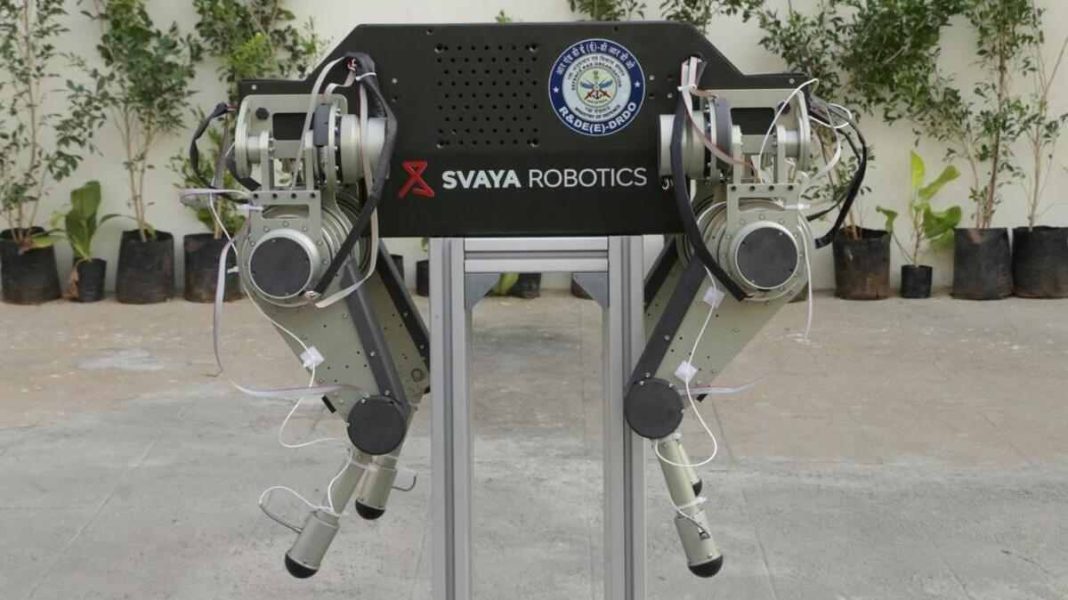We are often terrified by the visuals we see in Sci-Fi movies, where robots conquer the human world and destroy everything! But in reality, that possibility is minuscule. Rather, a future where robots and humans working together in harmony seems more likely. Already, there are several humanoid robots working in different sectors and assisting humans seamlessly. But it is very interesting to see how the defense sector around the world is leveraging the combined force of AI, robotics, and ML. It is already transforming the landscape for warfare, and experts believe that in the far future, Autonomous Weapon Systems (AWS) which require no to minimal human intervention, will be used to fight wars.
Development Of The First Quadruple Robot By India
The Centre for Artificial Intelligence and Robotics (CAIR) is a unit of the Defense Research and Development Organization (DRDO) that mostly oversees the development and research in the fields of robotics, AI, networking, information and communication security, command, and control. But interestingly, a Hyderabad-based company by the name of Svaya Robotics has developed India’s first quadruple robot and a wearable exoskeleton, which have changed the dynamics of robotics in the Indian defense sector. They have collaborated in design and technology with two DRDO labs, which include the Defense Bioengineering & ElectroMedical Laboratory (DEBEL) in Bangalore and Research and Development Establishment (R&DE) in Pune.
To strengthen the country’s defense, these quadruple robots were previously acquired from Switzerland and the USA. But now, with the collaboration of DRDO and Svaya Robotics, the “Made in India” initiative is also spreading its wings in the robotics sector. The current robots that are employed by the Indian Defense Ministry are not adept enough for field operations and in the rough terrain that the country has. They are more suited to an organized environment with minimal capabilities. Experts from the DRDO labs, along with the former chairman of DRDO and scientific advisor to the Union Defense Ministry, Mr. Sateesh Reddy, visited the research facility of Svaya Robotics in Hyderabad to examine the progress. Mr. Reddy was not only enthralled by the swift progress of the project but also highlighted the point and the need for such partnerships with DRDO to make the nation proud. Vijay R. Seelam, founder and managing director of Svaya Robotics, expressed his joy and commitment to working in collaboration with DRDO and believes that within 2 years the quadrupole robot and the exoskeletons will be made available in the market.
About Svaya Robotics
Svaya Robotics was founded in 2018 by Vijay R. Seelam, who had a vision of the possibility of humans and robots working together. He amassed a team of world-class engineers to feed his vision and came up with ideas to develop robots that would unlock new potentialities for businesses; making business operations adaptive to a more flexible and productive change. Svaya Robotics has always tried to come up with robots that are reliable and simple and can be used by anyone and anywhere with convenience.
Several products have been built by Svaya Robotics before they partnered with DRDO to make the exoskeleton and quadruple robot. The list of products includes models SR-L3, SR-L6, SR-L10, SR-L12, and SR-L16. These robots can perform a variety of tasks, from assembling to quality checking, and they can be seamlessly placed across any industrial environment due to their built-in PLC (Programmable Logic Controller) and communication protocols (Modbus, EtherCAT, Profinet, EtherNet/IP) for automation.
How Can The Army Use The Quadruple Robot And The Exoskeleton?
The introduction of the indigenous quadruple robot and the exoskeleton in the Indian Army will totally change the defense scenario of the country, as they will find numerous uses. Some of them are:
- In India, there are many rough terrains with unfavorable conditions where soldiers patrol and inspect for the safety and security of the country. The quadruple robot can be easily introduced in these areas to capture visuals that can be monitored from any part of the country.
- Svaya Robotics has mentioned that quadruple robots have the ability to carry a 25 Kg payload and move along with the soldiers. In catastrophic situations, soldiers will be able to carry more ammunition, rations, or any other important things. The robots can even be used for delivering such things to soldiers on uneven terrain without assistance.
- Often, soldiers have to carry a huge amount of gear with them in tough climatic conditions for several miles. Not only does this make them exhausted and fatigued, but in the long run, they also become susceptible to serious health conditions. The use of the exoskeleton can reduce this burden by up to 50%, making things more comfortable and useful for the soldiers.
Future Of India’s Usage Of Robotics In Defense
Daksh, an indigenously created ROV with X-ray vision and a jet water diffuser, finds its usage for disposing of bombs, and the EyeROV TUNA, an underwater drone, is used for surveying the waterways. Among plenty of other robotics used in Indian defense, these are two solid examples. But with the incorporation of the exoskeleton and quadruple robots in the future, India will set the bar high for many of its neighboring countries, and with companies like Svaya Robotics collaborating with the government, the future looks inspiring.
See more: ‘ChatGPT’ Explained: Will ChatGPT End Google’s Relevance?


